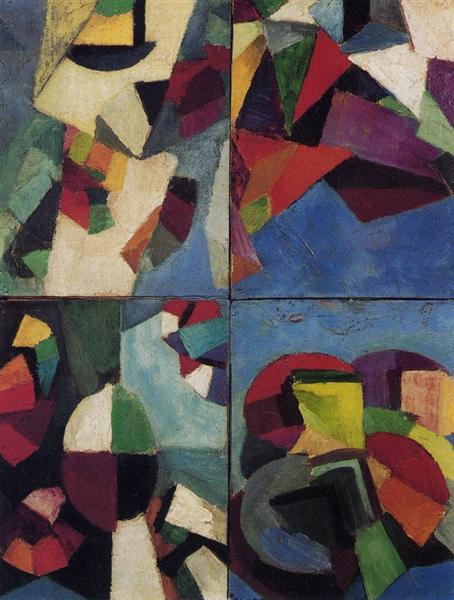
Synchromism
Art movement
Synchromism was an art movement founded in 1912 by American artists Stanton MacDonald-Wright (1890-1973) and Morgan Russell (1886-1953). Their abstract "synchromies," based on an approach to painting that analogized color to music, were among the first abstract paintings in American art. Though it was short-lived and did not attract many adherents, Synchromism became the first American avant-garde art movement to receive international attention. One of the difficulties inherent in describing Synchromism as a coherent style is connected to the fact that some Synchromist works are purely abstract while others include representational imagery.
Synchromism is based on the idea that color and sound are similar phenomena and that the colors in a painting can be orchestrated in the same harmonious way that a composer arranges notes in a symphony. Macdonald-Wright and Russell believed that, by painting in color scales, their visual work could evoke the same complex sensations as music. As Macdonald-Wright said,"Synchromism simply means 'with color' as symphony means 'with sound.'" The phenomenon of "hearing" a color or the pairing of two or more senses--synesthesia—was also central to the work of Wassily Kandinsky, who was developing his own synesthetic paintings, or "compositions," in Europe at approximately the same time.
The abstract "synchromies" are based on color scales, using rhythmic color forms with advancing and reducing hues. They typically have a central vortex and explode in complex color harmonies. The Synchromists avoided using atmospheric perspective or line, relying solely on color and shape to express form. Macdonald-Wright and Russell were among a number of avant-garde artists at work in the period immediately before World War I who believed that realism in the visual arts had long since reached a point of exhaustion and that, to be meaningful in the modern world, painting needed to sever any ties to older ideas about perspective and to literary or anecdotal content.
The earliest Synchromist works were similar to Fauvist paintings. The multi-colored shapes of Synchromist paintings also loosely resembled those found in the Orphism of Robert and Sonia Delaunay. MacDonald-Wright insisted, however, that Synchromism was a unique art form and "has nothing to do with Orphism and anybody who has read the first catalogue of Synchromism ... would realize that we poked fun at Orphism." The Synchromists' debts to Orphism remain a source of debate among art historians. Their approach more clearly owed something to Cubism. The Synchromists made use of the broken planes of the Cubists, but their lavishly colored areas of paint sometimes looked, as the art historian Abraham Davidson has described them, like "eddies of mist, the droplets of which collect to form parts of a straining torso....To find anything like this in American painting one has to wait for the color-field canvases of Jules Olitski in the 1960s."
Synchromism was developed by Stanton MacDonald-Wright and Morgan Russell while they were studying in Paris during the early 1910s. In 1907, Stanton MacDonald-Wright studied with optical scientists such as Michel-Eugene Chevreul, Hermann von Helmholtz, and Ogdon Rood in order to further develop color theory influenced by musical harmonies. Then from 1911 to 1913, they both studied under the Canadian painter Percyval Tudor-Hart, whose color theory connected qualities of color to qualities of music, such as tone to hue and intensity to saturation. Also influential upon MacDonald-Wright and Russell were the paintings of the Impressionists, such as Cézanne and Matisse, along with the Cubists, which heavily emphasized color over drawing. In addition to the Cubists and Impressionists, MacDonald-Wright and Russell were also inspired by artists such as Emile Bernard, who was a Cloisonnist, and the Synthetist Paul Gauguin for their unique explorations of the properties and effects of color. Russell coined the term "Synchromism" in 1912, in an express attempt to convey the linkage of painting and music.
This is a part of the Wikipedia article used under the Creative Commons Attribution-Sharealike 3.0 Unported License (CC-BY-SA). The full text of the article is here →
Wikipedia: https://en.wikipedia.org/wiki/Synchromism